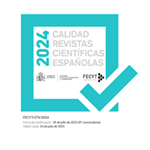La identidad de género a través del humor en niños y niñas de 10 años
Resumen
El presente trabajo se propone analizar un corpus de 148 redacciones humorísticas de niños y niñas de nueve y diez años que forma parte del corpus CHILDHUM, a fin de detectar las diferencias de género en el uso de los procedimientos lingüísticos asociados a la consecución del humor, que interpretamos como indicadores de la conciencia metapragmática infantil. Por ello, en primer lugar delimitamos la relación entre las producciones humorísticas y la competencia metapragmática, para analizar después el humor desde una perspectiva de género. A continuación, nos centramos en los niños y su desarrollo metalingüístico y metapragmático, pues todo ello nos sirve de marco teórico para justificar el análisis de los datos con que trabajamos. Este análisis revela diferencias de género en las situaciones que los niños interpretan como humorísticas y permite perfilar la identidad que los niños proyectan en sus narraciones cómicas. En general, las niñas se presentan más como protagonistas de situaciones absurdas o embarazosas, mientras ellos muestran una gran autoestima al sobreponerse con éxito a los choques culturales presentes en sus narraciones sobre un hipotético viaje a Marte.Descargas
Descarga artículo
Licencia
La revista Círculo de Lingüística Aplicada a la Comunicación, para fomentar el intercambio global del conocimiento, facilita el acceso sin restricciones a sus contenidos desde el momento de su publicación en la presente edición electrónica, y por eso es una revista de acceso abierto. Los originales publicados en esta revista son propiedad de la Universidad Complutense de Madrid y es obligatorio citar su procedencia en cualquier reproducción total o parcial. Todos los contenidos se distribuyen bajo una licencia de uso y distribución Creative Commons Reconocimiento 4.0 (CC BY 4.0). Esta circunstancia ha de hacerse constar expresamente de esta forma cuando sea necesario. Puede consultar la versión informativa y el texto legal de la licencia.











